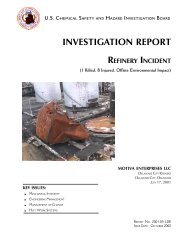CTA Report, Draft 1, ISP Review - US Chemical Safety and Hazard ...
CTA Report, Draft 1, ISP Review - US Chemical Safety and Hazard ...
CTA Report, Draft 1, ISP Review - US Chemical Safety and Hazard ...
You also want an ePaper? Increase the reach of your titles
YUMPU automatically turns print PDFs into web optimized ePapers that Google loves.
II controllers, only manufactured after January 1, 1998. The Type II display assembly was re-fitted<br />
into a Type I harness <strong>and</strong> Type I operator fronts.<br />
C.2 Conclusions<br />
The Crane-Powers temperature controller, tested in phase 4, was reported to have lost all data due to loss<br />
of power <strong>and</strong> backup battery failure. It is not clear why the battery failed. The battery draws down<br />
whenever the controller is not powered <strong>and</strong> is not rechargeable. The Moore Industries controller<br />
technician estimated that the average life of the controller’s battery was 5 years. If the date code on the<br />
controller display harness were consistent with controller <strong>and</strong> battery installation, then a battery with a life<br />
of 5 years likely would have expired prior to 2002.<br />
In general, there are electrical incompatibilities between Type I <strong>and</strong> Type II assemblies, particularly the<br />
option board, the power supply board, <strong>and</strong> the microcontroller board. By design, these sub-components<br />
must be replaced in-kind in order for the controller to operate correctly. However, for the display<br />
assembly, electrical designs are compatible, in that the user may cross-populate between types to yield a<br />
workable solution. Testing during phase 4 determined that interchangeability between platforms is<br />
feasible <strong>and</strong> that the <strong>CTA</strong> temperature controller configuration did not present a significant failure mode<br />
with respect to controller integrity.<br />
There were indications that the burner control box had been open or not properly sealed during operations<br />
<strong>and</strong> was open at the time of the explosion. Plant debris (i.e., fiberglass, dust, oily material) was present in<br />
the interior of the burner control panel <strong>and</strong> on the inside of the temperature controller, which was intended<br />
to be mounted within a NEMA-rated equivalent protected environment. The contamination may have<br />
contributed to the reported controller problems; there was some improvement in operation after the<br />
internal circuit boards were cleaned during phase 4 testing.<br />
113









